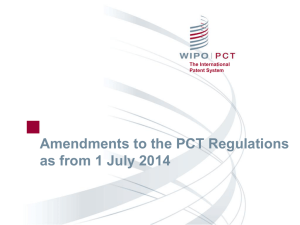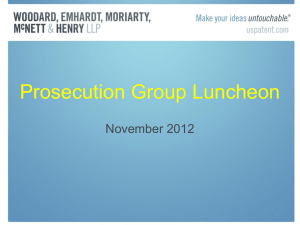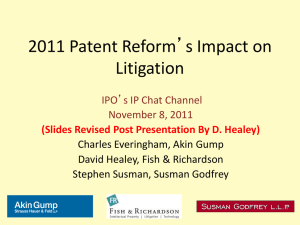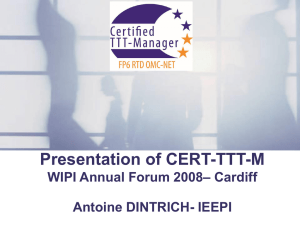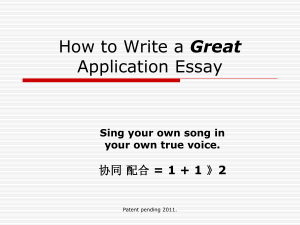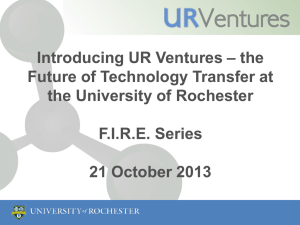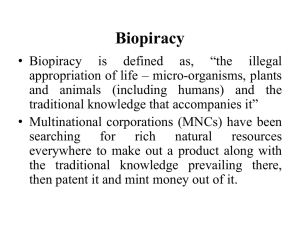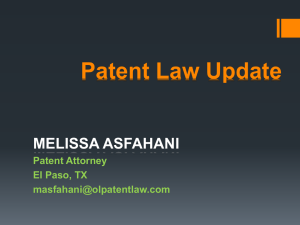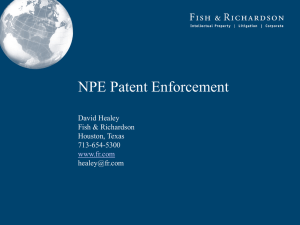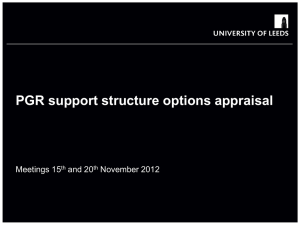Strategic Considerations of Post Issuance Patentability Review
advertisement
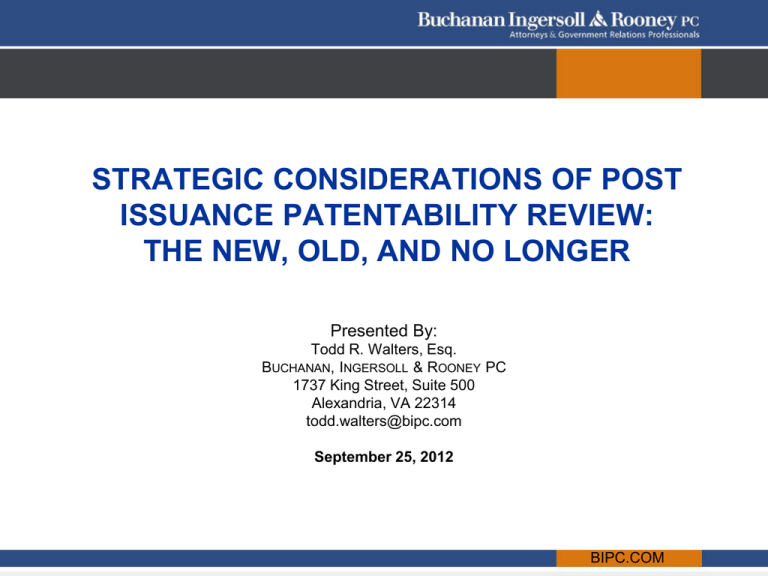
STRATEGIC CONSIDERATIONS OF POST ISSUANCE PATENTABILITY REVIEW: THE NEW, OLD, AND NO LONGER Presented By: Todd R. Walters, Esq. BUCHANAN, INGERSOLL & ROONEY PC 1737 King Street, Suite 500 Alexandria, VA 22314 todd.walters@bipc.com September 25, 2012 BIPC.COM The New Post-grant review (“PGR”) Inter partes review (“IPR”) Derivation proceedings Supplemental examination 1 BIPC.COM The Old Reissue Ex parte Reexamination Interferences/Derivation proceedings (claims having an effective filing date prior to March 16, 2013) 2 BIPC.COM The No Longer Inter Partes Reexamination (eliminated September 16, 2012) Interferences (claims having an effective filing date on or after March 16, 2013) 3 BIPC.COM Know the Law Understanding Options for Post Grant Review Starts with Knowing the Law □ Some options apply only to cases filed on or after March 16, 2013 □ Other Options apply to all cases □ Old Law/New Law—What standard applies? 4 BIPC.COM New Prior Art Provisions Apply to Applications and Patents Applies to any application for patent, and to any patent issuing thereon □ That contains or that contained at any time a claim to invention that has an effective date on or after March 16, 2013 5 BIPC.COM New Prior Art Provisions Apply to Applications and Patents Claiming Priority A specific reference under 120, 121 or 365(c) of Title 35 to any patent or application □ That contains or that contained at any time a claim to an invention that has an effective date on or after March 16, 2013 6 BIPC.COM Filing Strategies Informal survey suggests filing new applications prior to March 16, 2013 Most common reasons □ AIA expands available prior art to include foreign applications as of filing date in foreign country □ AIA expands on sale bar to activities in foreign countries □ AIA removes swear behind options □ AIA subjects claims to PGR (IPR available for all claims) 7 BIPC.COM POST-GRANT REVIEW (PGR) 8 BIPC.COM Post-Grant Review (PGR) Procedure Petition Filed PO Preliminary Response 3 months Decision on Petition No more than 3 months Petitioner Reply PO Reply PO Resp. & to PO Response to Opposition & Opposition to Motion to Amend Claims Amendment to Amendment 3 months PO Discovery Period 3 months 1 month Petitioner Discovery Period PO Discovery Period Oral Hearing Final Written Decision* Hearing set Observations & Motions to Exclude Evidence No more than 12 months *six month extension 9 BIPC.COM Post-Grant Review (PGR) THRESHOLD More likely than not that at least one challenged claim is unpatentable PTO BRANCH Patent Trial and Appeal Board (PTAB) IDENTIFICATION OF REAL PARTY IN INTEREST All Real Parties in Interest must be identified ESTOPPEL After final PTAB decision, the Real Party in Interest (RPI) is estopped from challenging its patent in the USPTO, ITC, or District Court on ANY ground that the RPI raised or could have reasonably raised during PGR 10 BIPC.COM Post-Grant Review (PGR) WHO CAN INITIATE? Third Party QUALIFICATION* Any patent having a claim with an effective filing date on or after March 16, 2013 TIMING Within 9 months after issuance of patent or reissue GROUNDS FOR FILING Any ground except failure to comply with best mode requirement *Business Method Patents 11 BIPC.COM Post-Grant Review (PGR) PTO FILING FEES $35,800 Petition Fee (for up to 20 claims) $800 for each claim in excess of 20 APPEALS COURT Federal Circuit SETTLEMENT Yes 12 BIPC.COM Post-Grant Review (PGR) PGR Petition can only be filed within 9 months of issue date of patent or reissue. 13 BIPC.COM Interim Procedures for Business Method Patents WHO CAN INITIATE? Third Party sued or charged with infringement QUALIFICATION Only “a covered business method patent” TIMING Only between September 16, 2012 and September 16, 2020 GROUNDS FOR FILING §§ 102/103 based on patents and publications 14 BIPC.COM INTER PARTES REVIEW (IPR) 15 BIPC.COM Inter Partes Review (IPR) Procedure Petition Filed PO Preliminary Response 3 months Decision on Petition No more than 3 months Petitioner Reply PO Reply PO Resp. & to PO Response to Opposition & Opposition to Motion to Amend Claims Amendment to Amendment 3 months PO Discovery Period 3 months 1 month Petitioner Discovery Period PO Discovery Period Oral Hearing Final Written Decision* Hearing set Observations & Motions to Exclude Evidence No more than 12 months *six month extension 16 BIPC.COM Inter Partes Review (IPR) WHO CAN INITIATE? Third Party QUALIFICATION Any patent TIMING The later of 9 months after issuance of patent or reissue OR After termination of Post-Grant Review GROUNDS FOR FILING §§ 102/103 based on patents and publications 17 BIPC.COM Inter Partes Review (IPR) THRESHOLD A reasonable likelihood that the petitioner would prevail with respect to at least one challenged claim IDENTIFICATION OF REAL PARTY IN INTEREST All Real Parties in Interest must be identified ESTOPPEL After final PTAB decision, the Real Party in Interest (RPI) is estopped from challenging its patent in the USPTO, ITC, or District Court on ANY ground that the RPI raised or could have reasonably raised during IPR 18 BIPC.COM Inter Partes Review (IPR) PTO FILING FEES $27,200 Petition Fee (for up to 20 claims) $600 for each claim in excess of 20 APPEALS COURT Federal Circuit SETTLEMENT Yes 19 BIPC.COM Inter Partes Review (IPR) IPR Petition can only be filed 9 months after issue date of patent or reissue OR termination of PGR, whichever is later. 20 BIPC.COM Inter Partes Review (IPR) IPR Petition must be filed within 1 year of service of Complaint alleging infringement. IPR Petition may not be filed if a civil action challenging the validity of a claim is filed. 21 BIPC.COM Compare With Litigation Burden of Proof □ Preponderance of Evidence vs. Clear and Convincing Evidence Claim Construction □ Broadest Reasonable Construction vs. Construction That Upholds Validity (file history estoppel) Decision Maker □ Technically Trained and Familiar With Patent Law vs. Judge/Jury Timing □ One Year (with short extension) vs. Multiple Years Cost □ Tens of Thousands Up to Several Million vs. Several Million and Up Discovery □ Limited vs. Broad 22 BIPC.COM Compare With Reexamination Burden of Proof □ Preponderance of Evidence Claim Construction □ Broadest Reasonable Construction Decision Maker □ Panel of Three APJs vs. Examiner Timing □ One Year (with short extension) vs. Multiple Years Cost □ Tens of Thousands Up to Several Million vs. Tens of Thousands Participation □ Full vs. Limited 23 BIPC.COM PGR/IPR Relationship to Civil Action PRG/IPR barred by previously filed civil action □ PRG/IPR Petitions barred if petitioner has already filed a civil action challenging validity of a claim of the patent □ IPR Petition barred if filed more than one year after being served with complaint Counterclaims □ Do not constitute a civil action challenging the validity of a claim 24 BIPC.COM PGR/IPR Relationship to Civil Action Civil action stayed by PRG/IPR □ Civil action filed after PRG/IPR Petition is automatically stayed until: A. Patent owner moves court to lift stay; B. Patent owner files a civil action or counterclaim alleging petitioner has infringed the patent; or C. Petitioner moves the court to dismiss the action. 25 BIPC.COM Preliminary Injunctions If a civil action alleging infringement of a patent is filed within 3 months after the date on which the patent is granted, the court may not stay its consideration of the patent owner’s motion for a preliminary injunction on the basis of PRG. 26 BIPC.COM SUPPLEMENTAL EXAMINATION 27 BIPC.COM Supplemental Examination WHO CAN INITIATE? Patent Owner QUALIFICATION Any patent OR Any information believed to be relevant to the patent (Declarations, public sale before critical date, submission of litigation papers, incorrect entity status claimed) TIMING Before patent expires GROUNDS FOR FILING Any information relevant to patentability 28 BIPC.COM Supplemental Examination THRESHOLD Substantial new question of patentability ESTOPPEL Patent is prevented from being held unenforceable in a court proceeding on the basis of conduct relating to information that had not been considered or was incorrect, if submitted or corrected during Supplemental Examination 29 BIPC.COM Supplemental Examination PTO FILING FEE $5,140 EFFECT OF CONCURRENT PROCEEDING Patent is not unenforceable on basis of information that was considered, reconsidered or corrected during Supplemental Examination APPEALS COURT Patent Trial and Appeal Board (PTAB) 30 BIPC.COM Summary Proceeding Reissue Inter Partes Reexam Ex Parte Reexam Inter Partes Review Applicability Effective Date Timing Threshold Estoppel Possibility of Settlement Patent owners to correct errors in their patents Any third party to challenge patentability based on patents and publications Historic Before patent expiration date N/A N/A N/A 11/29/199909/15/2012 Before patent expires or 6 months after expiration Any ground raised or could have been raised during reexamination N/A Any person to challenge patentability based on patents and publications Third party to challenge patentability based on patents and publications Historic Before patent expires or 6 months after expiration SNQ before 09/16/2011 or after IF reasonable likelihood that petitioner would prevail on at least 1 claim SNQ None No 09/16/2012 9 months after issuance of patent or reissue OR after termination of PGR Reasonable likelihood that petitioner would prevail with respect to at least 1 claim Any ground raised or could have been reasonably raised during IPR Yes 31 BIPC.COM Summary Proceeding Post-Grant Review Supplemental Examination PGR for business method patents Applicability Third party to challenge patentability on any ground except failure to comply with best mode requirement Patent owner to submit information relevant to patentability Third party to challenge patentability on patents and publications (requires petitioner to be sued for or charged with infringement of covered business method patent) Effective Date Timing Threshold Estoppel Possibility of Settlement 09/16/2012 Within 9 months after issuance of patent or reissue More likely than not that at least 1 challenged claim is unpatentable Any ground raised or could have been reasonably raised during PGR Yes 09/16/2012 Before patent expires SNQ None N/A 09/16/201209/16/2020 Before patent expiration More likely than not that at least 1 challenged claim is unpatentable Any ground raised or could have been reasonably raised during PGR Yes 32 BIPC.COM Summary Proceeding Derivation Applicability Inventor to challenge patentability of an earlier application by showing that the invention was derived from the inventor of the later application Effective Date Timing 03/16/2012 Within 1 year of publication of a claim to the derived invention Threshold Estoppel Possibility of Settlement Claim same or substantially same invention within 1 year of first publication of claim N/A Yes 33 BIPC.COM Questions? 34 BIPC.COM
